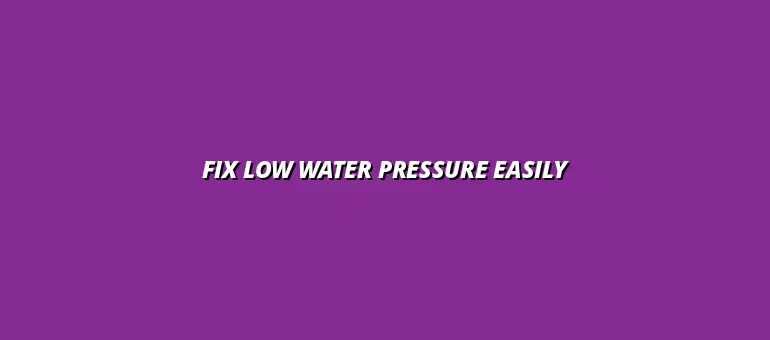
2024-12-26
Low water pressure in bathrooms can be a frustrating issue that affects your daily routine. It refers to the reduced flow of water, making it challenging to enjoy a refreshing shower or quick rinsing of hands. This situation can arise from various factors and can significantly impact how we experience our essential bathroom fixtures.
There are several common causes of low water pressure that can make your bathroom experience less enjoyable. These include clogs in pipes, issues with the municipal water supply, or even problems within your home's plumbing system. Understanding these causes can help you identify the problem sooner and fix it effectively! If you're experiencing issues with your drains, you might find this guide on how to unclog your bathroom drain easily helpful.
Low water pressure can stem from several sources, so it's essential to know what to look for! Here are some typical causes:
Recognizing these factors helps us take the right steps to restore water pressure. When water pressure drops, it can lead to frustrating experiences in your bathroom, making it essential to address these issues promptly! For example, a leaky faucet can contribute to low pressure and reduced water efficiency; learn how to fix your leaky bathroom faucet.
Identifying the symptoms of low water pressure can save you time and hassle in resolving the issue. Here are some signs to look out for:
If you notice these symptoms, it could mean that your bathroom is indeed suffering from low water pressure. Ignoring these signs can lead to more severe plumbing issues down the line, so it's best to investigate the cause as soon as possible! Regular maintenance can extend the lifespan of your bathroom plumbing; check out these tips for long-lasting bathroom plumbing.
To effectively tackle low water pressure, it’s crucial to pinpoint its source. By identifying the area of concern, we can address the problem more efficiently. This often starts by checking the bathroom fixtures themselves, as they can sometimes be the root of the issue.
First and foremost, inspect your bathroom fixtures, such as faucets, showerheads, and toilets. Here’s what you should look for:
Cleaning or replacing these components can significantly improve water pressure. Remember, a quick inspection can save you a lot of trouble later! Replacing your showerhead is a relatively easy DIY project; learn how to replace your showerhead easily.
Next, we need to consider the plumbing system that services your bathroom. Here are some potential issues that can lead to low water pressure:
Assessing your plumbing system can help you determine if a deeper issue exists. Addressing these concerns promptly can lead to a more efficient and enjoyable bathroom experience! If you suspect a leak in your kitchen sink, this guide on repairing a leaky kitchen sink could be helpful.
Low water pressure in bathrooms can stem from several factors. Understanding these causes can help you tackle the issue more effectively. Here are some of the most common reasons:
By keeping these potential causes in mind, you'll be better prepared to diagnose and address the issue in your bathroom. Regularly flushing your water heater can help maintain optimal water pressure and efficiency; see how to flush your water heater easily.
To determine whether low water pressure is a bathroom-specific issue or part of a larger plumbing problem, follow these guidelines. Start by checking the water pressure in other areas of your home:
By performing these checks, you can identify if the low water pressure is isolated to your bathroom or if it’s a more widespread plumbing concern. For plumbing services in Billesley, Birmingham, consider contacting a local professional like this plumber in Billesley, Birmingham.
Resolving low water pressure is often manageable with the right approach. Here’s a quick summary of the key steps you can follow:
By systematically addressing these issues, you can effectively restore water pressure in your bathroom.
Sometimes, despite our best efforts, plumbing issues can become complex. If you find yourself overwhelmed or unsure, it’s crucial to consult a professional plumber. A skilled expert can provide a thorough assessment and offer solutions tailored to your specific situation.
Moreover, seeking professional help can prevent further complications and save you time and money in the long run. Don't hesitate to reach out if you feel the issue requires expert attention!
At Bathroom Fix Pro, we are committed to sharing expert plumbing tips that empower homeowners and DIY enthusiasts alike. With a focus on bathroom renovations and installations, we strive to create functional and beautiful spaces that resonate with your unique vision.
